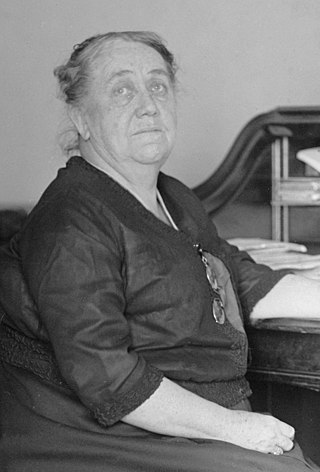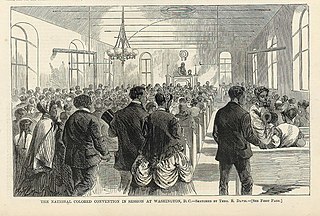
The Nineteenth Amendment to the United States Constitution prohibits the United States and its states from denying the right to vote to citizens of the United States on the basis of sex, in effect recognizing the right of women to vote. The amendment was the culmination of a decades-long movement for women's suffrage in the United States, at both the state and national levels, and was part of the worldwide movement towards women's suffrage and part of the wider women's rights movement. The first women's suffrage amendment was introduced in Congress in 1878. However, a suffrage amendment did not pass the House of Representatives until May 21, 1919, which was quickly followed by the Senate, on June 4, 1919. It was then submitted to the states for ratification, achieving the requisite 36 ratifications to secure adoption, and thereby go into effect, on August 18, 1920. The Nineteenth Amendment's adoption was certified on August 26, 1920.

The National American Woman Suffrage Association (NAWSA) was an organization formed on February 18, 1890, to advocate in favor of women's suffrage in the United States. It was created by the merger of two existing organizations, the National Woman Suffrage Association (NWSA) and the American Woman Suffrage Association (AWSA). Its membership, which was about seven thousand at the time it was formed, eventually increased to two million, making it the largest voluntary organization in the nation. It played a pivotal role in the passing of the Nineteenth Amendment to the United States Constitution, which in 1920 guaranteed women's right to vote.

The League of Women Voters (LWV) is a nonprofit, nonpartisan political organization in the United States. Founded in 1920, its ongoing major activities include registering voters, providing voter information, and advocating for voting rights. In addition, the LWV works with partners that share its positions and supports a variety of progressive public policy positions, including campaign finance reform, women's rights, health care reform, gun control and LGBT+ rights.

Carrie Chapman Catt was an American women's suffrage leader who campaigned for the Nineteenth Amendment to the United States Constitution, which gave U.S. women the right to vote in 1920. Catt served as president of the National American Woman Suffrage Association from 1900 to 1904 and 1915 to 1920. She founded the League of Women Voters in 1920 and the International Woman Suffrage Alliance in 1904, which was later named International Alliance of Women. She "led an army of voteless women in 1919 to pressure Congress to pass the constitutional amendment giving them the right to vote and convinced state legislatures to ratify it in 1920" and "was one of the best-known women in the United States in the first half of the twentieth century and was on all lists of famous American women."

Women's legal right to vote was established in the United States over the course of more than half a century, first in various states and localities, sometimes on a limited basis, and then nationally in 1920 with the passing of the 19th Amendment to the United States Constitution..

Harriet Taylor Upton was an American political activist and author. Upton is best remembered as a leading Ohio state and national figure in the struggle for women's right to vote and as the first woman to become a vice-chair of the Republican National Committee.

Laura Clay, co-founder and first president of the Kentucky Equal Rights Association, was a leader of the American women's suffrage movement. She was one of the most important suffragists in the South, favoring the states' rights approach to suffrage. A powerful orator, she was active in the Democratic Party and had important leadership roles in local, state and national politics. In 1920 at the Democratic National Convention, she was one of two women, alongside Cora Wilson Stewart, to be the first women to have their names placed into nomination for the presidency at the convention of a major political party.
Hannah Maria Conant Tracy Cutler was an American abolitionist as well as a leader of the temperance and women's suffrage movements in the United States. Cutler served as president of the Ohio Woman Suffrage Association and the American Woman Suffrage Association (AWSA). Cutler helped to shape the merger of two feminist factions into the combined National American Woman Suffrage Association (NAWSA).

Emma Smith DeVoe was an American women suffragist in the early twentieth century, changing the face of politics for both women and men alike. When she died, the Tacoma News Tribune called her Washington state's "Mother of Women's Suffrage".

The Woman Suffrage Procession on March 3, 1913, was the first suffragist parade in Washington, D.C. It was also the first large, organized march on Washington for political purposes. The procession was organized by the suffragists Alice Paul and Lucy Burns for the National American Woman Suffrage Association (NAWSA). Planning for the event began in Washington in December 1912. As stated in its official program, the parade's purpose was to "march in a spirit of protest against the present political organization of society, from which women are excluded."

The Colored Conventions Movement, or Black Conventions Movement, was a series of national, regional, and state conventions held irregularly during the decades preceding and following the American Civil War. The delegates who attended these conventions consisted of both free and formerly enslaved African Americans, including religious leaders, businessmen, politicians, writers, publishers, editors, and abolitionists. The conventions provided "an organizational structure through which black men could maintain a distinct black leadership and pursue black abolitionist goals." Colored conventions occurred in thirty-one states across the US and in Ontario, Canada. The movement involved more than five thousand delegates and tens of thousands of attendees.

Women's suffrage was established in the United States on a full or partial basis by various towns, counties, states and territories during the latter decades of the 19th century and early part of the 20th century. As women received the right to vote in some places, they began running for public office and gaining positions as school board members, county clerks, state legislators, judges, and, in the case of Jeannette Rankin, as a member of Congress.

Elise Clay Bennett Smith, President of the Kentucky Equal Rights Association from 1915–1916, also served as an Executive Committee member for the National American Woman Suffrage Association. Her last name changed several times as she married three men in succession: from her birth surname of Bennett she became Smith, then Jefferson, and finally Gagliardini.
The West Virginia Equal Suffrage Association (WVESA) was an organization formed on November 29, 1895, at a conference in Grafton, West Virginia. This conference and the subsequent annual conventions were an integral part of the National American Woman Suffrage Association's Southern Committee's work to reach into previously under-represented areas for supporting the women's suffrage movement. The WVESA relied not only on the national association but also worked together with activists from the state's chapter of the Woman's Christian Temperance Union, state chapter of the General Federation of Women's Clubs, and the clubs affiliated with the National Association of Colored Women's Clubs to win the right to vote. Though they lost in a landslide the 1916 referendum to amend the state's constitution for women's suffrage, the group provided the strong push for ratifying the federal amendment in spring 1920 that led to West Virginia becoming the thirty-fourth of the thirty-six states needed. That fall, West Virginia women voted for the first time ever, and the WVESA transformed itself into the League of Women Voters of West Virginia.
Anna Beulah Boyd Ritchie was a founding member of the Fairmont Woman Suffrage Club, third president of the West Virginia Equal Suffrage Association, and officer in the West Virginia Woman's Christian Temperance Union.

Women's suffrage in Ohio was an ongoing fight with some small victories along the way. Women's rights issues in Ohio were put into the public eye in the early 1850s. Women inspired by the Declaration of Rights and Sentiments at the 1848 Seneca Falls Convention created newspapers and then set up their own conventions, including the 1850 Ohio Women's Rights Convention which was the first women's right's convention outside of New York and the first that was planned and run solely by women. These early efforts towards women's suffrage affected people in other states and helped energize the women's suffrage movement in Ohio. Women's rights groups formed throughout the state, with the Ohio Women's Rights Association (OWRA) founded in 1853. Other local women's suffrage groups are formed in the late 1860s. In 1894, women won the right to vote in school board elections in Ohio. The National American Woman Suffrage Association (NAWSA) was headquartered for a time in Warren, Ohio. Two efforts to vote on a constitutional amendment, one in 1912 and the other 1914 were unsuccessful, but drew national attention to women's suffrage. In 1916, women in East Cleveland gained the right to vote in municipal elections. A year later, women in Lakewood, Ohio and Columbus were given the right to vote in municipal elections. Also in 1917, the Reynolds Bill, which would allow women to vote in the next presidential election was passed, and then quickly repealed by a voter referendum sponsored by special-interest groups. On June 16, 1919, Ohio became the fifth state to ratify the Nineteenth Amendment.

This is a timeline of women's suffrage in Ohio. Women's suffrage activism in Ohio began in earnest around the 1850s, when several women's rights conventions took place around the state. The Ohio Women's Convention was very influential on the topic of women's suffrage, and the second Ohio Women's Convention in Akron, Ohio, featured Sojourner Truth and her famous speech, Ain't I a Woman? Women worked to create organizations and groups to influence politicians on women's suffrage. Several state constitutional amendments for women's suffrage did not pass. However, women in Ohio did get the right to vote in school board elections and in some municipalities before Ohio became the fifth state to ratify the Nineteenth Amendment.

Laura Gregg Cannon was an American lecturer and organizer in the women's suffrage movement. Over the course of almost three decades, she led or supported suffrage activities in fifteen different states. She was a Life Member of the National American Woman Suffrage Association (NAWSA). Cannon edited a suffrage publication and wrote on labor issues. She was a national speaker for the Socialist Party.
Frances Ellen Burr was an American suffragist and writer from Connecticut.



















